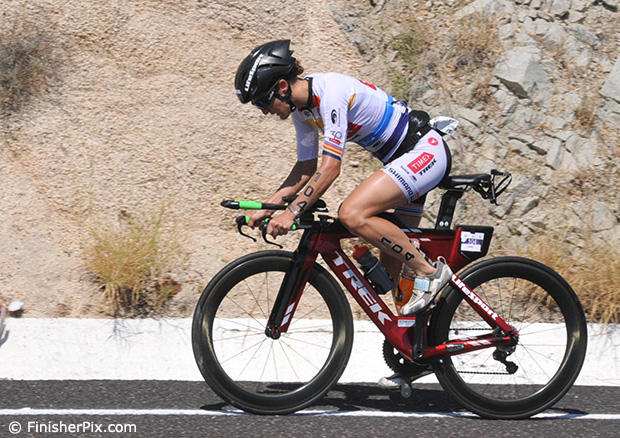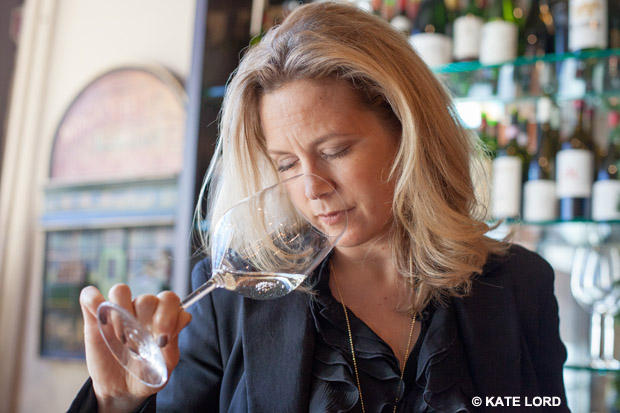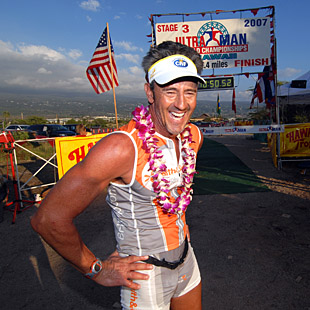An Olfactory Tour of the Big Island
When I met Bertrand Dor a decade ago, I was fascinated to meet a man who creates perfumes for a living, which I came to understand is a process akin to composing symphony. At the same time, Bertrand was an aficionado of ultra endurance sport – including the three day, 321-mile Ultraman Triathlon. Bertrand presents an exquisite contrast: he is a man who submits himself to the athletic discipline of extended pain for fun, and for his work, he creates a luxurious sensual pleasure through his refined sense of smell. Although the human sense of smell is feeble compared to that of many animals, it is still very acute. We can recognize thousands of different smells, even in infinitesimal quantities. His mastery of scents opens the multiple climatic zones of Hawaii to potentially inspire a new perfume. In a sport that is so physically demanding that most participants shut out of consciousness their sense of smell, Bertrand is the striking exception. He offers the reader a new perspective on one of nature’s most unique sporting venues.

At a post-race celebration at a seaside condominium after the 2005 Ultraman at which he finished near the end of the field in 34 hours and nine minutes, I found Bertrand a willing guide to his professional point of view as it related to the Ultraman’s triathletic circumnavigation of the Big Island of Hawaii. Standing on the terrace overlooking the ocean, I asked Bertrand about the sensory input he got that evening at a barbecue by the shore.
"The first impression is a wonderful marine, ‘ozonic’ freshness coming from the ocean waves that are crashing on the rugged lava rocks below,” he said. “The smell of salt reminds me of something a little metallic, like clean, very clean, stainless steel metal. While it is watery, the salt makes the scent just a little bit abrasive, a little bit rough, enough to notice the coldness of the metal.”
“Then the spray travels through the palm and the coconut trees planted nearby, charging it with some green leafy and very subtle woody notes. Perfumers talk about it as a ‘chord,’ like in a music composition. We perfumers actually work as organists using different types of notes to create a well-rounded, artistically pleasing fragrance."
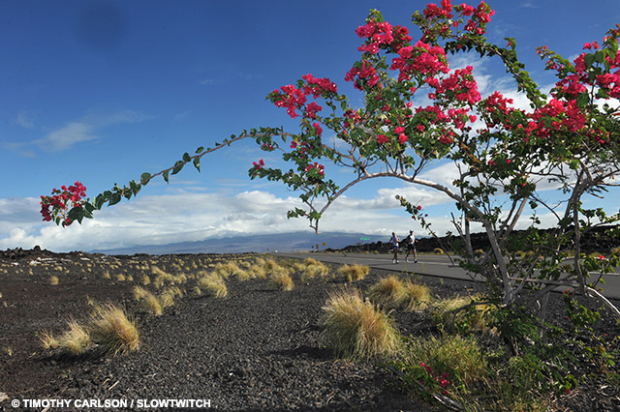
Bernard first competed at Ironman Hawaii in 1983, and I wondered what smells he noticed in his first exposure to the Big Island.
“In retrospect, I think what I experienced first was more like an ambiance than a smell per se. The course of my impression was a combination of the light, the sun and the entire lighting of this island. In terms of the scents of Kona, I was mostly struck by the contrast between the stark black lava and yellow grass which combines to make a very strong warm odor, almost like when a field is being harvested and dust is flying around. It is a dry smell, like straw, with a hint of parched wood and hot tar.”
What was the most striking sensual impression he felt in his first competitive outing at Hawaii??
“That first year I got hit by a little bit of a rain on the road. Then all of a sudden you had this steam coming up from the lava fields and the ground which made it very interesting. When drizzling rain hits this hot plate, the lava field, to me it gives out a smell somewhat similar to decaying wood. Not in a bad sense, but an old wood, an old tree that you know is drying. Mist just adds a little more sap to the wood. Then it fizzes out and gives a note similar to when you take laundry from a washing machine that has been spun wet but not dry.”
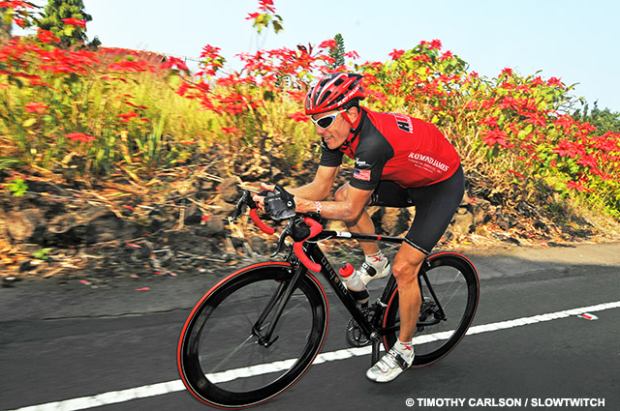
Twenty-two years later, in 2005, Dor had his first encounter with Ultraman – and by then he was a veteran perfumer as well as a veteran of 25 Ironman events. As I understand it, he called upon his olfactory experiences in life as an inspiration for some of his perfumes. I asked Bertrand recall his sensations of that first circumnavigation of the Big Island.
“At the end of the first day of the race, finishing at Volcanoes National Park was such a relief from a hard day spent struggling in the heat. Leaving the coast to the final 20 miles relentlessly climbing towards the mountains, the landscape drastically changed and so did the smells emanating from the surroundings. As I walked through the garden of my bed and breakfast accommodation for the night, I found myself overcome by the scents of tropical rain forest, hummus and green leaves, the relaxing scents of wood, and moss, but also floral scents from some of the flowers like the pikake or the plumeria – the traditional blossoms used for making leis in Hawaii. The sensation is like the feeling you get when you drink alcohol and are on the verge of being tipsy. The smell is almost euphoric. Then on top of these notes, of course, there is the ever present smell of sulfur emanating from the volcano, which adds a little interest. The mist and fog surrounding the area also helps in enhancing and diffusing these different notes.”
On the second day of the race, Bertrand discovered the southern part of the island around Kalapana – a town in the Puna District on the Island of Hawai’i where in 1990, lava flowing from the Kupaianaha vent of Kilauea destroyed and partly buried most of the town, as well as the Kalapana Gardens and nearby Royal Gardens subdivisions. The wild and scenic Kapoho Kalapana Road, also known as the Red Road because of its original red cinder pavement (now sadly paved over with a uniform black asphalt), travels 15 miles along the Big Island’s southeastern coastline of the lower Puna district. It is about 40 miles into the Day 2 Ultraman bike course and is one of the most scenic roads in the state of Hawaii. It was this section that struck Bertrand most vividly.
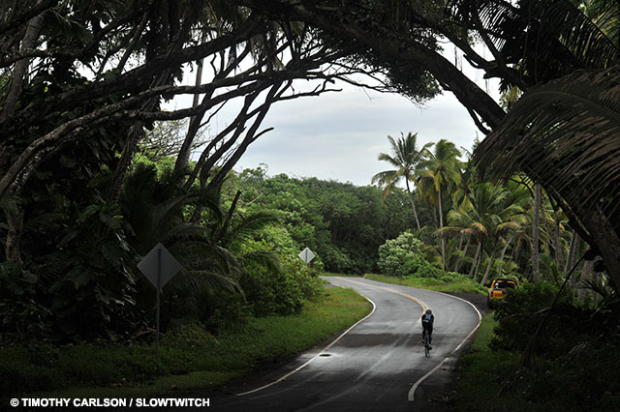
“Riding my bike on Red Road was to me like riding through a tunnel of trees and jungle vegetation with occasional openings on both side of the road through which you could peek. On my right, the tunnel of trees would briefly open to views of the ocean and the occasional either black or white sand beaches littered with bleached wood and decaying palm fronds. My nose was overwhelmed by the spray of the water, carrying what I interpreted as the scent of cold steel, the scent of salty water and a little bit of sand, then the scent of dry wood. There were also some wild local trees dropping fruits on the road from which emanated a fermented odor, adding a very nice warm middle note to the perfume. On the left side of the tunnel, as I kept riding my bike, was a deeper forest. There you find all your heavier components like wood, earth, moss and eventually some musk from some of the animals – I don’t know what they are. By riding along that road, I can imagine an entire perfume arising that would set it off from other perfumes. It’s going to be interesting!”
In order to more fully explain the process of creating a perfume, Bertrand uses a musical metaphor.
“Creating a perfume is like when you play piano – you cannot only use the left keys. You must blend with some right hand keys. Maybe the chord comes from the left and main theme from the right. Or it can be the reverse. It is a very subjective ratio. They are all very different. But that is the way I see it.”
Surprisingly, perfumers create exquisite and elegant fragrances which include infinitesimally small doses of some nasty materials.
“Riding through a public garden in the town of Hilo, you come across Banyan trees. The Banyan tree bears some fruits and a multitude of birds eat these fruits. Their droppings give out a little bit of an animal and fecal odor. It is not bad, actually. We use civet musk in some perfumes – the glandular secretion produced by both sexes of the civet, a long bodied, short–legged carnivore with a thick furred tail, small ears and pointed snout found in Asian and Southern European rain forests. That smell is pretty nasty, but in very small quantities it adds a lot of depth to a perfume and helps with the 'sillage' – or trail – of the perfume.”
Further along the second day bike course, Dor chronicles some ever changing scents as the route veers away from the ocean.
“After Hilo is a long ride north on the Hamakua Coast along very lush and green vegetation as well as many fruit farms. Although the road follows the coastline at the beginning, it does so from high up a cliff, which makes for very scenic views, but in terms of scents, you do not experience the ‘marine’ effect as much as before. Here are more leafy, green and fruity notes.”
As the climb steepens, Bertrand notes the effect of increasing wind and the odors of the ranches.
“As you climb more inland, turning your back to the ocean, towards Waimea, the wind starts to pick up. With it, first comes the faint smell of open pastures and cows and thus manure, growing stronger as I struggle through the climb and get closer to town. It is still a green smell, but with a light musky fecal odor.”
The climb up the spine of the Kohalas presents a severe change in climate and terrain and olfactory sensations.
“I make a right turn to climb up the spine of the Kohalas. All of a sudden the landscape and climate change completely. The landscape has a different feel, somewhat similar to climbing along pastures in the lower Alps. It is a lot fresher in terms of odor and a lot more aromatic. There is something like anise and fennel with an aroma almost like a drink of anise or absinthe.
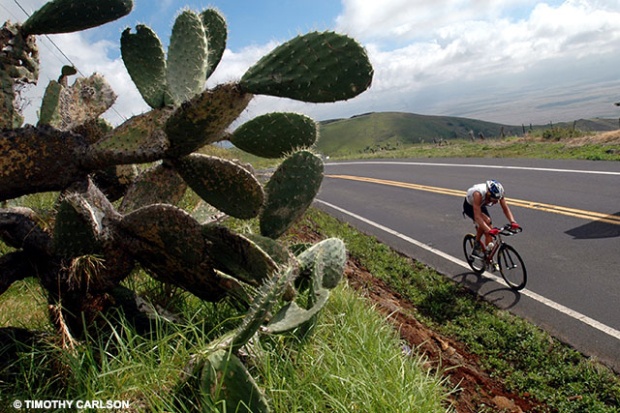
They blend very well with the cactus, which emanates a milky green odor. Imagine Granny Smith apples – a green smell and taste. And if you put milk on it, it smells creamier and less tart, less acidic. The fennel along with the dry grass by the side of the road creates a totally different aromatic picture. That also could be an inspiration for a nice new fragrance, to evoke that special place on the island.”
Despite the high speeds and stiff winds, the scent of roadside trees made an impression on Bertrand.
“After reaching the summit of the Kohala road at something like 3,300 feet, you descend through the Parker Ranch. While you are descending on the steepest point at 45 mph, the road is flanked by rows of eucalyptus, a tree that smells like gum, juniper and cypress. Those aromas inspire another different scent, like men’s cologne.”
The end of the second day brings Ultraman competitors to the charming village of Hawi, the beginning of the run back to Kailua the next day and an entirely new set of scents.
“In Hawi you are 500 feet above the ocean so you do not smell the ocean as much. As soon as you leave town, the only kind of vegetation you find on the side of the road are various bushes and wind-torn, low lying trees. Here I find a very defined odor of dry wood, dry leaves and very dry berries also. There is one element that stands out. If you see a tumbleweed bush, it doesn’t smell like anything else. It is like dry sand and dry straw with an odor so faint, you can just barely smell it. It smells like a dry piece of vegetable. There is no excess of juice and softness.”
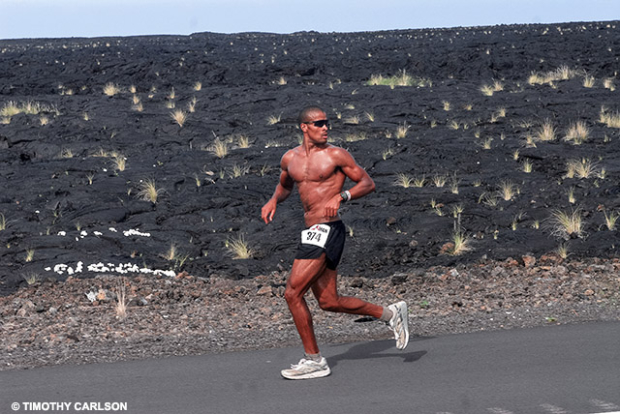
After passing Kawaihae and its cement plant, the run enters the most rugged lava fields.
“By that time of the day you already feel the heat, not only that, but you also ‘smell’ the heat reflected on the tarmac of the road, blended with the scent of dry grass. That's pretty much it until you get to the entrance to the Mauna Kea Hotel and the other hotels nearby where landscapers planted bougainvillea, hibiscus and plumeria bushes. All of a sudden you get a welcome breath of fresh green with a bit of a soft floral combination which is very pleasant.”
The Ultraman double marathon passes through the signature landscape of Hawaii and Bertrand discovers a signature scent.
“From then on, it is my favorite portion of the run, up to the Scenic Overlook [20 miles to the finish]. To me, that's Hawaii. Madame Pele is right there. Madame Pele is wearing something really simple. It’s charred lava and yellow grass, and the combination is not a lush perfume.
It’s very typical for a perfume to have contrasts – a top note and a low note. Here it’s nothing in between – a very simple but potent contrasting combination. The lava to me smells like a very warm, dark wool blanket. Then you have the yellow grass mixed with a slightly ozonic marine bouquet. I think it’s a combination of acidity of the grass mixed with a breath of lava that makes it really interesting.”
Nearing the end of the triathletic circumnavigation, there is physical relief and some welcoming fragrances.
“As a competitor, it makes me feel good to know I’m coming home! As a perfumer, there are not a lot of different notes at this point on the course. You get the same note over and over. The problem is there is so much traffic on your left when you run south you do not smell much of anything but the fumes from the cars. But when you’re about a mile from the airport and see palm trees, bougainvillea and hibiscus, it’s a refreshing sight and then it does smell a lot fresher.”
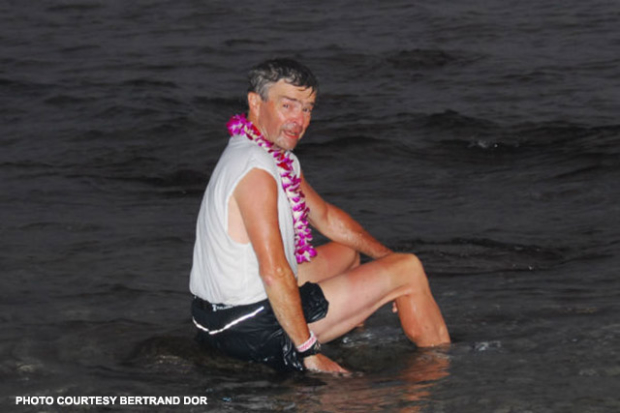
While there are many different exotic careers listed in Ironman and Ultraman fields, Bernard Dor is the only perfumer and Ironman/Ultraman. Might he bring his olfactory notes of the Big Island to a new fragrance? He is retired and, so far, no. But he keeps working the scents of Hawaii over in his mind.
“That was a nice tour of the beautiful island of Hawaii and maybe someday I will be working on an experimental fragrance called Red Road.”


